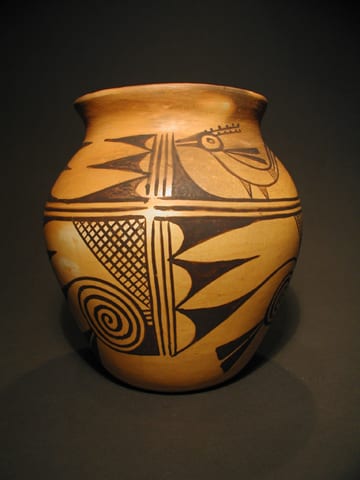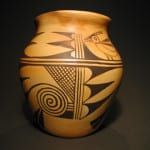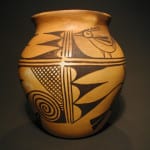Tall vase with monochromatic painting, including bird whirlpool and crosshatched patterns unsigned 1940s (?). Like 2001-04, the painting on this pot is unusual. If Alexander Stephen is correct and his interpretations can be projected forward 50 years, then the spirals on this jar may represent a whirlpool (the gate to Masau’s house) found near the sipipu salt dome on the Colorado River in the Grand Canyon. Crosshatches may represent cultivated fields. The bird figures reflect a payupki style (1680-1820), itself a reflection of Zuni influence. (See Patterson, 1994:29, 233 and 164.) Similar Zuni-inspired birds are also found on Polacca ware, Style C (Wade & McChesney, 1981:235, 369 and 595; see also, the Blairs, 1999:99). Of course, it is also probable that the potter simply painted a design she enjoyed without any conscious reference to prior cultural meaning.
Purchase History:
Purchased on 5/20/99 from Medicine Man Gallery. Mark Sublette provided extensive provenance for the piece:
"This pot is from a three-generation Arizona collection. They were purchased by Gertrude Harkey Passey, who at the time lived at 36 S. Hibbert in Mesa, AZ (the street no longer exists). Mrs. Pasey was a colorful woman who appreciated beautiful things. Her beginnings were quite modest, so it wasn’t until later in life that she was able to put together her beautiful, eclectic collection. Gertrude Harkey grew up in a mining camp, the oldest of nine children. Gertrude had to grow up very quickly; her family was quite poor, and she had a great deal of responsibility at a young age….After marriage, she and her husband also had some tight times financially….(during the Great Depression) Mr. Passey repaid every note he signed, even though they were not his personal debits. To do this, Mr. Passey dug ditches, and Gertrude took in washing. They worked together as a couple, and after the depression (as Arizona started to really grow), they were more prosperous. At that time, Gertrude was able to acquire some of the beautify things she had wanted for so long. As she advanced in age, Gertrude lived with her only daughter, Julienne Passey. Naturally, the collection passed on to Julienne when Gertrude died. When Julienne was elderly, she lived with her daughter Sandra. Similarly, Sandra inherited the collection upon Julienne’s death. We acquired the pot (along with many other beautify items) directly from Sandra." ----------




